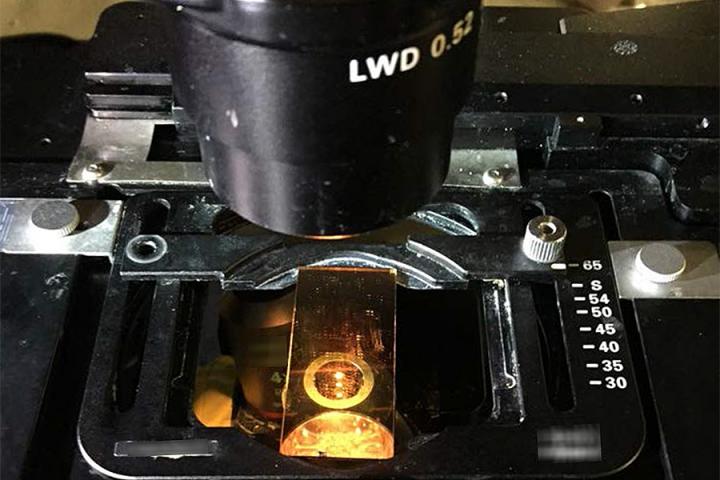Newly improved glass slide turns microscopes into thermometers

A photo of the experiment using a glass slide with the new coating. Credit: University at Buffalo
The humble glass microscope slide may be primed for a makeover.
A study published online today (May 2, 2018) in the journal Nature Communications describes how an updated version of this centuries-old tool can now enable scientists to see tiny objects while also measuring their temperature.
The advancement, made possible by a new transparent coating at the forefront of optics theory, has the potential to streamline and enhance scientific research worldwide, from clandestine government biology labs to high school chemistry classes.
It may also have implications in other industries, such as computers and electronics, whose products require measurement and control of heat in highly confined spaces.
“We have instruments that magnify incredibly small objects. And we have tools that measure heat, like infrared thermometers. But we haven't been able to combine them in a low-cost and reliable manner. This new coating takes a big step in that direction,” says the study's co-lead author Ruogang Zhao, PhD, assistant professor in the University at Buffalo Department of Biomedical Engineering.
The department is a multidisciplinary unit formed by UB's School of Engineering and Applied Sciences and the Jacobs School of Medicine and Biomedical Sciences at UB.
Zhao collaborated with researchers at the University of Pennsylvania, including co-lead author Liang Feng, PhD, assistant professor of materials science and engineering, and electrical and systems engineering.
For decades, researchers have tried to combine thermal imaging and microscopy. Images produced from systems that use thermocouples lack resolution and are often too coarse for modern science. Terahertz and infrared thermal mapping techniques interfere with the microscope's lenses. Other techniques are expensive and time-consuming.
The new coating is made of a layer of acrylic glass (the same material used in most eyeglasses) that's sandwiched between two layers of transparent gold. The gold is transparent because it's only 20 nanometers thick; a typical sheet of paper is 100,000 nanometers thick.
Engineers fabricated the coating so that “exceptional points” — the sweet spots where unusual light behavior happens — can develop within the tri-layered structure. The coating, which significantly enhances the slide's sensitivity to light detection, would be added to slides during the manufacturing process. Either the slide or cover slip could receive the coating.
To make use of the new coating, a laser is needed. Zhao says a common helium-neon laser, which can be seamlessly integrated with most microscopes, will do the job.
Common slides, which are often bought in bulk, typically cost around 5 cents. The new coating would likely add a few pennies to the cost, Zhao says.
###
The research is supported by funding from the National Science Foundation and the National Institutes of Health.
Media Contact
All latest news from the category: Materials Sciences
Materials management deals with the research, development, manufacturing and processing of raw and industrial materials. Key aspects here are biological and medical issues, which play an increasingly important role in this field.
innovations-report offers in-depth articles related to the development and application of materials and the structure and properties of new materials.
Newest articles

First-of-its-kind study uses remote sensing to monitor plastic debris in rivers and lakes
Remote sensing creates a cost-effective solution to monitoring plastic pollution. A first-of-its-kind study from researchers at the University of Minnesota Twin Cities shows how remote sensing can help monitor and…

Laser-based artificial neuron mimics nerve cell functions at lightning speed
With a processing speed a billion times faster than nature, chip-based laser neuron could help advance AI tasks such as pattern recognition and sequence prediction. Researchers have developed a laser-based…

Optimising the processing of plastic waste
Just one look in the yellow bin reveals a colourful jumble of different types of plastic. However, the purer and more uniform plastic waste is, the easier it is to…



